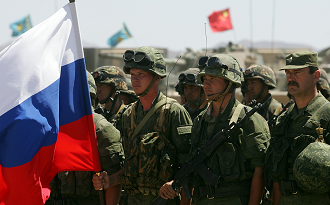Russia's hypersonic trump card edges closer to reality

Russia's newest ballistic missile the RS-26 Rubezh. Source: RIA Novosti
By the end of this year, Moscow will test its newest ballistic missile, the RS-26 Rubezh (which means frontier in Russian) equipped with hypersonic manoeuvring nuclear units. As Colonel General Vladimir Zarudnitsky, chief of the Main Operations Directorate of the General Staff of the Armed Forces, said to Vladimir Putin, this system will significantly expand the ability of Russian strategic nuclear forces to overcome missile defence systems. The technical specifications of the new missile have not been disclosed. However, public recognition of the fact that it has “hypersonic manoeuvring nuclear units” indicates it is an ultimate weapon.
“Ballistic missiles have a certain trajectory and power supply capacity. It is rather difficult to reach beyond these parameters in the development of new models of this type,” says Vladimir Dvorkin, the former head of the 4th Central Research Institute of the Ministry of Defence (the institution that studies the effects of nuclear weapons). “So currently the only thing that can be upgraded is most likely the warhead of ballistic missiles.”
Back in 1997, then Chief of General Staff Yury Baluyevsky announced proudly that Russia had developed a hypersonic cruise vehicle (HCV). Its flight path is non-classical, meaning it doesn't follow the classic parabola like a modern nuclear warhead, but can arbitrarily change directions. HCVs can enter outer space, and then re-enter the earth's atmosphere. A conventional nuclear warhead enters the dense layers of the atmosphere at a speed of 5,000 metres per second. The speed of the HCV is twice as high. This makes it very hard to detect with radar missile defence systems. In addition, as military personnel note, the HCV can be retargeted throughout its entire flight, unlike conventional warheads.
Currently, the U.S. is working on several hypersonic missiles: the HySTR, Hyper-X, and X-34. Some of them are modelled on the strategic ballistic missiles that were removed from service.
But there are other missiles. For example, at the MAKS-2013 air show a representative of the BrahMos Russian-Indian venture admitted that soon India will receive a hypersonic version of the anti-ship missile. According to him, a hypersonic engine for it has already been created and tested. The only ‘but’ delaying the finished product is the lack of materials that can protect its guidance system from overheating and subsequent failure. However, as can be seen from the work of the Russians, Moscow has already solved this problem. Not so long ago, Vladimir Popovkin, the former head of the Federal Space Agency, said that testing is being completed on the Zircon missile system. It includes a new hypersonic missile, created on the basis of the Onyx supersonic cruise missile (Russia's equivalent of the Indian BrahMos).
In early 1997 engineers from the Raduga Design Bureau in Dubna (located just outside Moscow) displayed a new class of airborne vehicle -- the Kh-90 hypersonic experimental cruise missile -- at the International Aviation Aerospace Salon (MAKS) in Zhukovsky. In the West, it was called the AS-19 Koala.
This rocket was made to replace the Kh-55 strategic cruise missile that is carried by the Tu-160 bomber. Its flight range was 3,000 km. The missile could carry two warheads with individual guidance, each capable of hitting targets at a distance of 100 km from the point of separation. The carrier of the X-90 was to be a modernised version of the Tu-160M strategic bomber. However, according to official data, work on the missile was suspended in 1992.
There were also more exotic designs. For example, one of the missile design bureaus proposed placing several supersonic or hypersonic cruise missiles instead of a nuclear warhead in a heavy ballistic missile. The designers thought that with this weapon, the Soviet Union would have been able to engage U.S. aircraft carrier fleets anywhere in the world directly from Siberia. A ballistic missile would carry the warhead into the targeted area, and there the cruise missiles themselves would detect and strike the target. The idea was abandoned because of its exorbitant cost, and the Koala was left as the only tangible evidence of the scientists' hypersonic research. All other development was kept top secret.
But after the United States stepped up its own work on hypersonic cruise vehicles, Moscow returned to its own hypersonic “trump cards,” including the RS-26 Rubezh “manoeuvring nuclear unit” ballistic missile.
All rights reserved by Rossiyskaya Gazeta.
Subscribe
to our newsletter!
Get the week's best stories straight to your inbox
